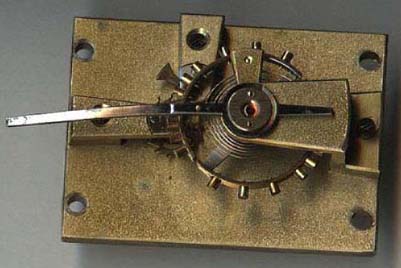
Jewelled-Lever Platform Escapements are found in quality Carriage Clocks mounted horizontally on top of the carriage clock movement, below the handle, with sometimes a bevelled-glass provided to view the action of the escapement.
The platform consists of a balance-wheel, hairspring, lever, and an escape wheel. An index lever projects from the balance cock to below the platform, where it is possible to regulate the clock via the door at the back, where also the hand-setting and winding are performed. (Picture below)

Cylinder Platform Escapements
Another type of platform escapement found is the Jewelled-Cylinder Escapement. These were made for French carriage clocks that were more cheaply produced.
Similar in appearance to the Lever Platform, the Jewelled Cylinder Platform consists of balance wheel, hairspring and cylinder escape wheel. These platforms generally have fewer jewels than the lever version. The stem or staff of the escape wheel is a hollow shell which is marvelously impulsed by the cylinder escape wheel via an array of tiny arrow-shaped heads. This is a method fairly unique in horology because the cylinder shell and the cylinder wheel are both steel. Two like metals engaging continuously wear more rapidly, and will not run if the oil dries out. The cylinder platform is prone to wear and inclined to need more regular maintenance than the lever one.
Because escapements are mounted above the clock plates, and 90 degrees in relation to the movement gear train, the platform escape wheel pinnion engages with a contrate gear wheel shaped like a crown. This is easily observed by looking through the glass sides of the carriage clock.
To regulate a platform escapement on a carriage clock, it is necessary to first open the door and look to see where the index stem is positioned at the top of the clock backplate. It should be positioned exactly mid-way between the stamped letters "F" and "S" Fast and Slow or 'A' 'R' / Advance and Retard. When the clock was first made, the index was set to the mid-point with the clock keeping time. If the index can be observed to be set well away from the centre point and the clock is running correspondingly fast or slow, then set the index to the middle again as it is likely that the index has been accidentally moved during winding or handsetting. On no account push or roughly treat the index, the merest touch to left or right by the forefinger is all that is required.
If the carriage clock has been at all exposed to a damp atmosphere over the 80-plus years of its life, then the hairspring is likely to have tarnished to some degree. This means that the balance spring may vibrate more slowly now and the index will now be set slightly towards Fast or Advance. Remember not to adjust the index unneccessarily. A clock will never become fast or slow spontaneously! Wind the clock regularly each week, at the same time. Setting the hands correctly. Study the clocks' timekeeping in this way before making any adjustment. Remember to be forgiving: timekeeping to within a few minutes per week is excellent for an antique clock.
A platform escapement in good order should run in any position, that is, a carriage clock must run upside down or on its side as well as it should standing upright. Similarly with a drum mantel clock or marine clock movement.
Never clean a carriage clock case with liquid metal polish or any metal cleaner. These clock cases can be dusted with a barely-damp soft linen cloth. Carriage cases are gilded(gold-plated) brass. They were never brass alone. It is vital not to rub through the gold surface in a mistaken attempt at cleaning. To inhibit tarnishing of the case where the gold has been worn away through handling, clear beeswax furniture polish will do no harm.
If the carriage clock is to be restored, a clear metal lacquer
can be applied to the case parts to keep the finish bright on
a case that has been diminished to brass by a 'metal polish zealot'
in the unenlightened past.
Copyright ©1998 - IAN PARTRIDGE . Revised, 8th May,1998